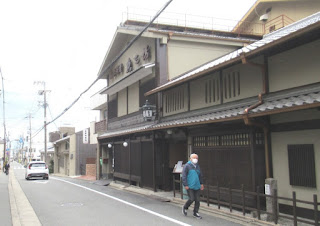Fushimi, which locates in the southern part of Kyoto City, has played an important role in many historical events in Japan. It is also famous for sake brewing.
Following yesterday's visit to Fushimi Inari Shrine, I visited important sights in Fushimi today. Many of the places I visited were located in or around the area where Fushimi shukuba station, one of the Tokaido’s 57 stations, was located.
Fushimi Castle was the political center of Japan at the end of the 16th century. Toyotomi Hideyoshi, who became the ruler of Japan, built his first castle here in 1592. After it collapsed due to an earthquake and was rebuilt, Hideyoshi died in Fushimi Castle in 1598.
Tokugawa Ieyasu also stayed in Fushimi Castle before establishing his shogunate in Edo in 1603. Fushimi Castle was abolished in the 1620s due to the policy of the Tokugawa shogunate.
In the 1960s, a concrete castle that imitated the castle at that time was built in a part of the area where Fushimi Castle was located. Cherry blossoms were beautiful around the castle today.(See also the top photo)
The tomb of Emperor Meiji (1867-1912) was also built in the area where Fushimi Castle was located.
The approach to the tomb goes through the forest.
Along the approach, stone walls that were once used in Fushimi Castle are displayed.
Many important events took place in Fushimi during the turmoil period at the end of the Edo era. The Edo Shogunate and anti-Shogunate forces such as Satsuma and Choshu fought each other. The control power was returned from the Shogunate to the Imperial power in 1967, but the Battle of Toba-Fushimi took place between the new government forces and the Shogunate forces in 1968.
Sakamoto Ryoma, who contributed to the establishment of cooperation between the anti-Shogunate forces, is one of the most popular figures in Japanese history. Teradaya, where Ryoma used as his base of activities and where he was injured in an attack by Shogunate forces in 1866, remains as it was. (See also the 2nd photo)
The nearby shopping street was named Ryoma Street, reflecting his popularity. (See also the 3rd photo)
Many of Fushimi's towns were burned down and damaged during the Battle of Toba-Fushimi. Bullet marks from the battle remain on the lattice doors of Uosaburou, a traditional Japanese fish restaurant near Fushimi-Momoyama Station of the Keihan Line.
During the battle, government forces led by Saigo Takamori and others established their base at Gokonomiya Shrine, near the shukuba town.
Fushimi is rich in clean water and is a major producer of sake.
There are springs in
Gokonomiya Shrine.
Nationally famous brewers such as Kizakura and Gekkeikan have their headquarters and breweries in Fushimi. The photo on the left shows Gekkeikan's museum. Kizakura also has an exhibition room and a shop, attracting visitors.(See the 4th photo)
There are also many foreign tourists here. The tributaries of the Uji River run through the chity, and many tourists were enjoying the scenery on cruise boats.



















No comments:
Post a Comment